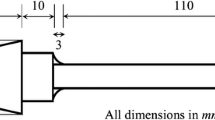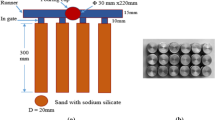Abstract
Chromium carbonitride coatings were formed on plain carbon and alloy steels by pre-nitrocarburizing, followed by thermoreactive deposition and diffusion in a salt bath below 700 °C. In the present study, an artificial neural network-based model (ANNs) was developed to predict the layer thickness of pre-nitrided steels. Seventeen parameters affecting the layer thickness were considered as inputs, including the pre-nitriding time, salt bath compositions ratio, salt bath aging time, ferrochromium particle size, ferrochromium weight percent, salt bath temperature, coating time, and different chemical compositions of steels. The network was then trained to predict the layer thickness amounts as outputs. A 2-feed-forward back-propagation network was developed and trained using experimental data form literatures. Five steels were investigated. The effects of coating parameters on the layer thickness of steels were modeled by ANNs as well. The predicted values are in very good agreement with the measured ones indicating that the developed model is very accurate and has the great ability for predicting the layer thickness.





Similar content being viewed by others
References
Nakanishi K, Takeda H, Tachikawa H, Arai T (1992) Fluidized bed carbide coating process-development and its application. In: The 8th international congress on heat treatment of materials, heat and surface’92, Kyoto Nagoya, Japan
Arai T, Fujita H, Sugimoto Y, Ohta Y (1988) Vanadium carbonitride coating by immersing into low temperature salt bath. In: Proceedings of the 6th international conference on heat treatment of metals, ASM International, Chicago, USA
Chicco B, Borbidge WE, Summerville E (1999) Experimental study of vanadium carbide and carbonitride coatings. Mater Sci Eng A266:62–72
King PC, Reynoldson RW, Brownrigg A, Long JM (2004) Cr(N,C) diffusion coating formation on pre-nitrocarburised H13 tool steel. Surf Coat Technol 179:18–26
Arai T, Endo J, Takeda H (1987) Method of surface treatment and apparatus used therefore, in European Patent 252,480
Arai T, Takeda H, Kawaura H (1988) Method and apparatus for surface treatment, in European Patent 303,191
Arai T, Nakanishi K, Takeda H, Tachikawa H (1991) Method of forming a nitride or carbonitride layer, in European Patent 471,276
Ohta Y, Sugimoto Y, Arai T (1992) Low temperature salt bath coating of chromium carbonitride, heat and surface. Japanese Heat Treatment Society, Kyoto, pp 503–506
Perlovsky LI (2001) Neural networks and intellect. Oxford University Press, New York
Haque ME, Sudhakar KV (2002) ANN back propagation prediction model for fracture toughness in microalloy steel. Int J Fatigue 24:1003–1010
Nazari A, Milani AA, Zakeri M (2011) Modeling ductile to brittle transition temperature of functionally graded steels by artificial neural networks. Comput Mater Sci 50:2028–2037
Nazari A, Sedghi A, Didehvar N (2011) Modeling impact resistance of aluminum-epoxy laminated composites by artificial neural networks. J Compos Mater. doi:10.1177/0021998311421222
Nazari A, Riahi S (2011) Artificial neural networks to prediction total specific pore volume of geopolymers produced from waste ashes. Neural Comput Appl. doi:10.1007/s00521-011-0760-x
Nazari A (2011) Application of artificial neural networks for analytical modeling of Charpy impact energy of functionally graded steels. Neural Comput Appl. doi:10.1007/s00521-011-0761-9
Nazari A (2011) Microhardness profile prediction of functionally graded steels by artificial neural networks. Int J Damage Mech. doi:10.1177/1056789511432653
Nazari A, Riahi S (2011) Prediction split tensile strength and water permeability of high strength concrete containing TiO2 nanoparticles by artificial neural network and genetic programming. Compos Part B Eng 42:473–488
Wahl G (1980) Salt bath nitriding—Tufftride TF1-AB1. Technical pamphlet from Degussa, Hanau
Xu L, Xing J, Wei S, Zhang Y, Long R (2006) Artificial neural network prediction of retained austenite content and impact toughness of high-vanadium high speed steel (HVHSS). Mater Sci Eng A 433:251–256
Xu L, Xing J, Wei S, Zhang Y, Long R (2007) Optimization of heat treatment technique of high-vanadium high-speed steel based on back-propagation neural networks. Mater Des 28:1425–1432
Bahrami A, Mousavi Anijdan SH, Ekrami A (2005) Prediction of mechanical properties of DP steels using neural network model. J Alloy Compd 392:177–182
Arai T, Sugimoto Y (1985) In: Proceedings of 20th conference, The Japan society for heat-treatment, Osaka, Japan, p 37
Arai T, Fujita H, Sugimoto Y, Ohta Y (1988) In: Heat treatment and surface engineering: new technology and practical applications. Proceeding of conference, ASM International, USA, p 49
Arai T, Fujita H, Sugimoto Y, Ohta Y (1989) Ind Heat 56:30
Arai T (1990) In: Sudarshan TS, Bhat DG (eds) Surface modification technologies III. The Minerals Metals and Materials Society, USA, p 587
Bohlooli H, Nazari A, Kaykha MM (2011) Microhardness profile prediction of functionally graded steels by artificial neural networks. Int J Damage Mech. doi:10.1177/1056789511432653
Acknowledgments
The authors would like to acknowledge the valuable support and guidance provided by Dr. Seyyed Mohammad Mousavi Khoei. The authors would like to thank Amir-Kabir University of Technology (Tehran Polytechnic) for providing the financial support of this research.
Author information
Authors and Affiliations
Corresponding author
Rights and permissions
About this article
Cite this article
Khalaj, G. Artificial neural network to predict the effects of coating parameters on layer thickness of chromium carbonitride coating on pre-nitrided steels. Neural Comput & Applic 23, 779–786 (2013). https://doi.org/10.1007/s00521-012-0994-2
Received:
Accepted:
Published:
Issue Date:
DOI: https://doi.org/10.1007/s00521-012-0994-2




